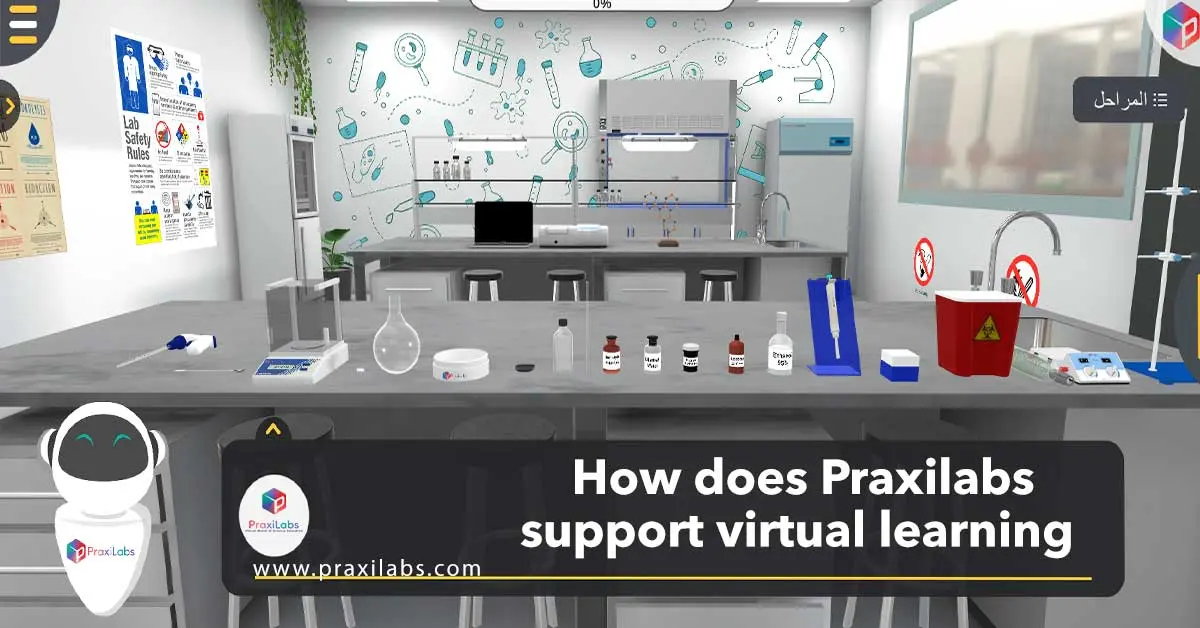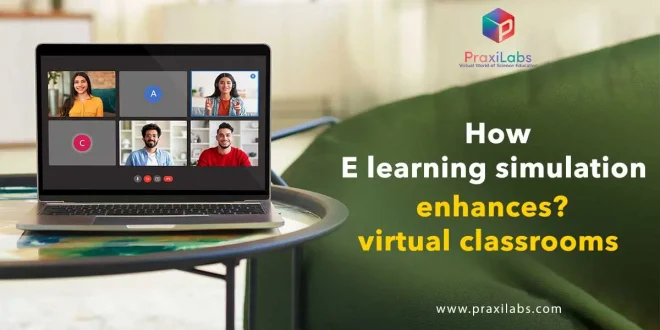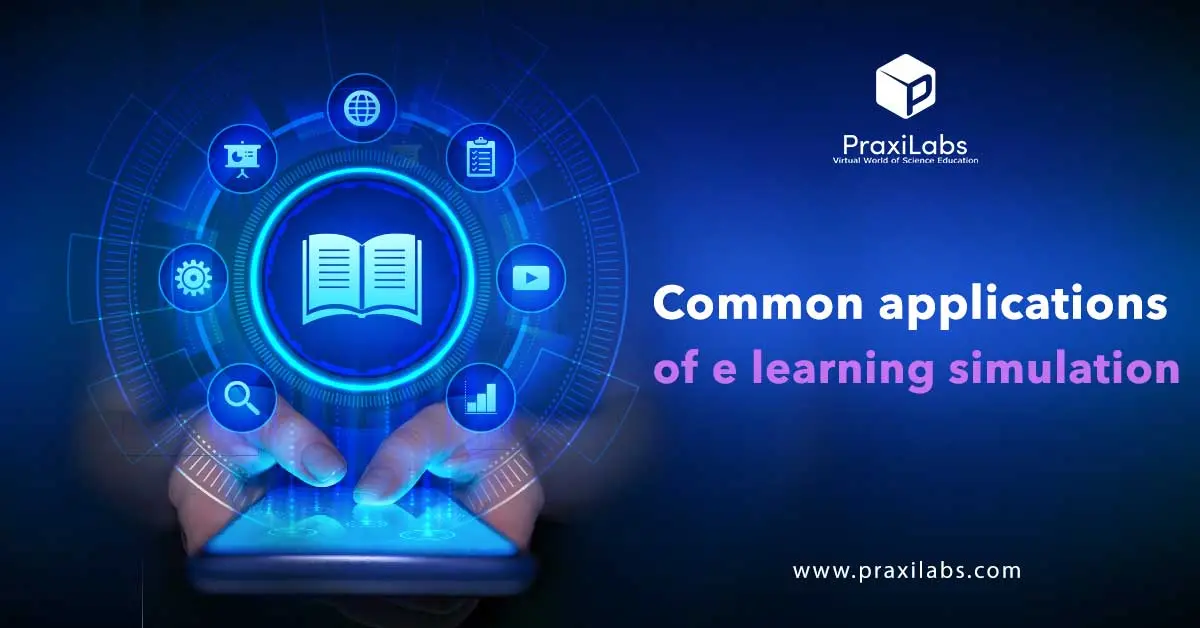Last Updated on September 18, 2025 by Muhamed Elmesery
As education continues its digital evolution, virtual classrooms are no longer just about video calls and shared screens. To truly engage learners and build practical skills, institutions are turning to e learning simulations.
These interactive tools bridge the gap between theory and practice, enabling students to apply knowledge in real-world scenarios without the limitations of physical classrooms. The result is a more immersive, effective, and future-ready approach to interactive online learning.
In this blog, we will focus on e learning simulation, common applications, benefits, how they improve students’ skills, how to choose the right platform, and Praxilabs’ latest 2025 achievements.
Table of Contents
What is an e learning simulation?
An e learning simulation is a digital interactive environment that simulates real-world scenarios. It is used in a controlled setting to train students or learners in a specific skill or task.
It allows individuals to practice, make decisions, and experience the consequences of their actions without the risks or costs associated with real-life mistakes, thus preparing them for actual job responsibilities.
That’s why simulations in eLearning allow learners to practice what they’ve learned in a risk-free setting where they don’t have to fear making mistakes that could lead to costly consequences in the real world.
Common applications of e learning simulation
There are several common applications of simulation in e learning across industries and education:
- Science education: virtual laboratories simulate real physical labs, where students can perform their experiments using these simulations without accessing the real lab.
- Medical & Healthcare: Simulations for anatomy, surgery practice, diagnostic training, and patient interactions.
- Language Learning: Conversational simulations for real-life practice.
- Engineering & Technical Fields: Virtual environments for testing designs, machinery, or systems without physical risks.
- Pharmaceutical Training: Practicing lab procedures and drug handling.
Let’s explain more about using virtual lab simulations in science education:
- Virtual labs play a vital role in academic settings, particularly in the fields of science, technology, engineering, and mathematics (STEM).
- These simulations enhance the understanding of scientific concepts and protocols, especially at the microscopic level, as they allow students to clearly visualize what happens inside these small creatures and other microscopic structures. They also help in enhancing educators’ visual impact and observational skills.
- virtual e learning simulations are critical in distance and remote learning systems, as they enable students to access and conduct experiments easily anytime and anywhere without difficulties. Moreover, 3D science simulations help students prepare before dealing with the real lab, since they conduct the experiments virtually first and this makes them understand the mechanisms, protocols, and principles of the experiments more effectively.
- Virtual laboratories increase student engagement, understanding, and learning experiences, which makes them effective supplementary learning tools in education.
Explore: Why every university should use a STEM virtual lab?
Benefits of using simulation-based learning
Simulation-based learning is one of the most important tools for remote education, and among its key benefits:
Providing students access to exceptional educational tools
E learning simulations are beneficial for students as they allow them access to advanced tools such as virtual labs, which are ideal for teaching them experimental techniques, detailed steps, and basic safety procedures so that they are prepared to conduct actual laboratory experiments in the future.
Help students understand complex concepts
Teachers can use online virtual simulations to efficiently convey complex theoretical ideas or intricate theories. These simulations provide students with useful practical procedures in a safe environment.
Engaging learners
By enabling students to participate in the educational process, e learning simulations help teachers capture students’ attention, making it more engaging and appealing to them compared to theoretical study.
Unlimited access
Simulations enable remote learners to study and benefit from available educational materials for an unlimited period. For example, when using virtual labs, students can repeat the experiment multiple times to grasp a particular topic.
Affordable alternative
The subscription costs for virtual simulation platforms are considered reasonable; setting up an online scientific laboratory simulation is much less expensive than setting up a real laboratory, and there are no ongoing expenses for supplies or laboratory maintenance.
Additionally, for educational institutions, virtual laboratories save a lot of money as they do not require a location or facilities like real laboratories.
How do eLearning simulations improve students skills?
E Learning simulations are not limited to providing an alternative educational environment to traditional education, but they also contribute to developing students’ academic skills in innovative ways that align with the demands of the digital age.
Academic achievement today is no longer just about memorizing information; it has become an interactive process that includes understanding, application, and critical thinking.
- E learning simulations rely on immersive interactive content that engages students and makes the learning process more exciting. This interactive content includes videos, virtual simulations, interactive activities, and other means that aim to increase understanding and achievement among students by linking theoretical aspects with practical ones.
- Virtual simulations allow for personalized learning based on each student’s level and preferred learning method. Through smart systems, student performance can be tracked individually, providing additional content or specific training to address their weaknesses, which significantly improves their level of achievement.
- Virtual education platforms include immediate assessment tools such as quizzes and reports, with the ability to track student performance and provide them with feedback on their performance to quickly correct errors and benefit from them, thus improving their achievement levels continuously.
Explore: Online lab for students for interactive STEM
How to choose the right virtual learning platform for your courses?
Here are some effective tips to choose the right virtual learning platform for your courses:
- Define and establish clear learning outcomes, which help in choosing the most suitable virtual learning platform that is aligned with educational goals.
- Foster deep learning for your students, as this approach improves critical thinking and problem-solving skills, since students must navigate complex scenarios that mimic real-world challenges.
- Provide support and guidance to your students before engaging with the online virtual learning platforms to help them understand the objectives. This preparation can increase students’ confidence and engagement.
- Incorporate technology wisely to enhance the learning experience.
- Evaluate the effectiveness of the online virtual learning platforms. This can be done through assessments, feedback from students, and analysis of learning outcomes.

Praxilabs’ latest 2025 achievements in supporting STEM e-learning
PraxiLabs awarded the STEM.org Accredited™ certification, recognizing the quality of its virtual science labs and their role in supporting innovative and safe STEM education, further strengthening its position as a leading edtech provider in virtual laboratories.
Check out Praxilabs’ 2025 milestones in driving STEM e-learning to new heights:
- Over 500,000 students empowered through immersive virtual labs.
- +100 partner institutions onboarded globally.
- 50 new experiments were added, spanning disciplines like biology, chemistry, physics, and engineering.
These achievements aren’t just numbers—they reflect a meaningful transformation in how STEM is taught and learned.
Ready to take your STEM education to the next level? Partner with Praxilabs and bring cutting-edge virtual labs to your students.
Whether you’re a university, high school, or training organization, reach out now to discover tailored solutions, hands-on STEM content, and measurable results for 2025 and beyond.
Frequently Asked Questions
What is simulation-based learning?
Simulation based learning is a type of learning that depends on using simulation software for education and virtual environments to mimic the real world with several features such as flexibility, safety, and cost effectiveness.
What are eLearning services?
e Learning services provide online education and training using digital tools and internet-based platforms, encompassing everything from corporate training and academic courses to skills enhancement programs.
Why is simulation-based learning a better learner engagement?
Because it provides active, hands-on experiences in authentic, realistic scenarios that are both engaging and safe to make mistakes.
 PraxiLabs A virtual world of science
PraxiLabs A virtual world of science







